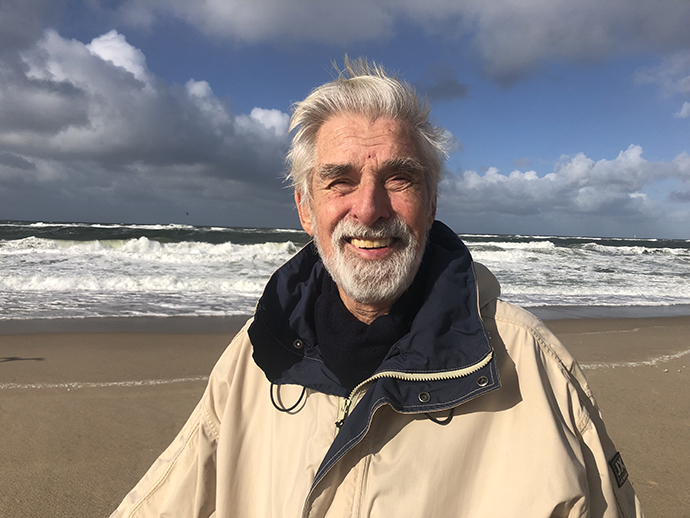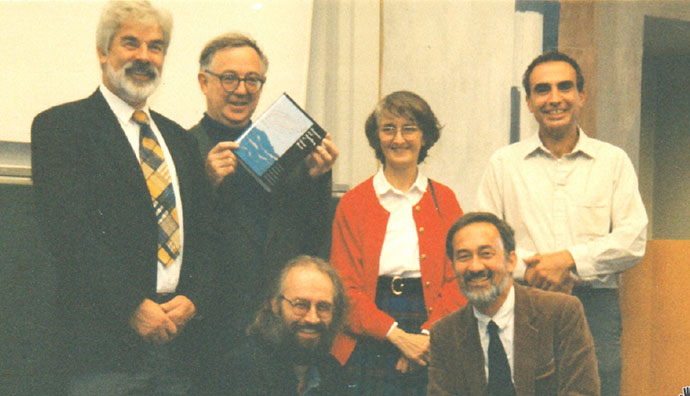The Nobel Prize in Physics was awarded in 2021 to Syukuro Manabe, Klaus Hasselmann and Giorgio Parisi in acknowledgement of their scientific work, thus giving a clear message on the relevance of the climate issue. Out of the three, Klaus was interested in a number of problems which closely intersected with activities at ECMWF. What follows is a short account of his role in the activities of the Centre relating to both practical and fundamental questions.

Ocean wave dynamics
With a degree in theoretical physics, the first contact Klaus had with the practical world was in oceanography, in particular wind waves. In 1960, he developed the concept of the energy balance equation, which is still the basis of all present wave forecasting models. In 1962, he shocked the oceanography community by showing that resonant four-wave interactions amongst gravity waves, which he represented by a perturbation expansion, play a key role in ocean wave dynamics. Four years later, he showed how the same problem can be solved using Feynman-type diagrams. He thus provided a sound explanation of why, during the evolution of ocean waves, their energy moves progressively to lower and lower frequencies. In 1973, the JONSWAP experiment gave the first empirical evidence of how wind waves evolve, followed one year later by the first quantification of the energy loss by white-capping.
All these theoretical and practical developments were ahead of time because computing capacity was very limited. But as soon as Cray computers became available, Klaus started interacting with Lennart Bengtsson, then Director of ECMWF, and a small group of wave modellers was formed trying to implement a sophisticated wave model at ECMWF, using the classroom as an office. However, the restriction was that only 10% of operational resources could be spent on wave forecasting, and even vector machines such as the Cray were not powerful enough to produce a reasonably accurate wave forecast. Once again, the solution was provided by Klaus and his wife Susanne, by developing an efficient approximation to the nonlinear interaction calculation, which is called the Discrete Interaction Approximation (DIA). Even after almost 40 years, the DIA is still the essential ingredient that makes wave forecasting possible at meteorological centres all over the world.
Coupled modelling
But Klaus’s interest was not restricted to wave modelling alone. His vision was to develop a comprehensive coupled ocean-wave and atmosphere model that would use global surface data, such as wind speed and direction, and sea-state parameters, such as wave height and wave spectrum, for initialisation of the coupled system. These data could only be provided by polar-orbiting satellites, so Klaus started interacting with the European Space Agency (ESA). He played an important role in the development of instruments such as the Scatterometer (surface winds) and the SAR (2D-spectrum of long waves) on board the first European Earth observation satellite ERS-1, which was launched in 1991. The coupled ocean-wave and atmosphere model was introduced in June 1998, and the wealth of wind and wave data has improved the performance of the ECMWF forecasting system ever since. At the same time, satellite data were instrumental in the validation of wave forecasting results, and many forecasting centres have obtained considerable improvements in the forecast skill of wave parameters by improving the ocean wave model.

Climate-related work
All this could easily lead you to consider that Klaus was mainly a wave man, but this would be far from the truth. His dominant interest (think of the Nobel Prize) was climate, and this is where, from a different perspective, his work is again related to ECMWF. In many of the climate models used in the 1960s and 70s, the atmosphere was not explicitly included. Instead, it was placed in the model’s statistical-diagnostic regime and was represented only through temporally averaged terms. However, in his seminal paper on ‘Stochastic climate models’ published in Tellus in 1976, Klaus pointed out that the atmosphere’s influence is not limited to these temporally averaged terms and that its variability must also be considered. This results in differential equations for the slow components of the climate system, which include stochastic forcing terms. Analogous to Brownian motion, these shortterm atmospheric variations cause long-term fluctuations in slow subsystems, which explains the observed red spectrum of slow climate variables. The theory of Brownian motion has been discussed in many applications since Einstein’s paper in 1905, but it had not yet been applied to geophysical systems, such as the climate system. In two follow-up 1977 papers, the applicability of the concept was demonstrated through an analysis of sea-surface temperatures and thermocline variability and with a global energy balance model. A large variety of different applications of this stochastic approach followed in subsequent years.
Having framed the physics and the limits to the predictability of the climate system, Klaus addressed the problem of detecting a meaningful signal amidst the noise of the past. This was achieved by introducing the concept of ‘detection and attribution’. First, in the detection step, the relevant change is examined to see if it falls within the range of natural variability. Having obtained a successful rejection, the change is compared with one or several theories. If a good fit is found, then the conclusion is drawn that the change can be attributed to the relevant factor(s). The concept was used successfully for investigating whether an external signal, as suggested by climate model simulations, would be detectable in the observational record of global temperatures. The technique was adopted in various corners of the academic world and eventually became a cornerstone in reports by the Intergovernmental Panel on Climate Change (IPCC): the fingerprint of human activity in a changing global climate.
From a general point of view, the concept of a possibly very wide range of frequencies interacting in a non-linear way forms the basis of various processes or timescales ECMWF deals with. An obvious example is the daily variations in weather details and the predictability of seasonal or longerterm forecasts. An application at the other, high-frequency end of the timescale is the effect of gustiness in wind fields on the average wind input to ocean waves. Klaus’s climate work is also important to the activities of the EU‑funded Copernicus Climate Change Service (C3S), which has been run by ECMWF since 2014. C3S offers information on the past, present and future climate, and it builds on Klaus’s insights, especially as under the C3S umbrella a coupled ocean–atmosphere reanalysis is being developed.
A fundamental role
The list of Klaus’s achievements is very long, especially when you realise that most of his work has been in fields different from meteorology. In our daily work for better results, with a steady look to the future, it is easy to forget that we stand on the shoulders of the greats of the past. Although his main interest was in climate, with later work on the economy and a unified theory of particles and fields, Klaus had a fundamental role in shaping some of the activities at ECMWF. Knowing that we are working on the shoulders of a Nobel Prize winner is, no doubt, a privilege and a great pleasure.

